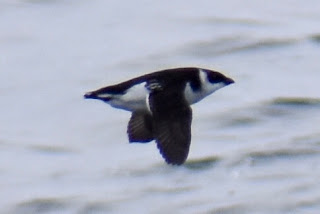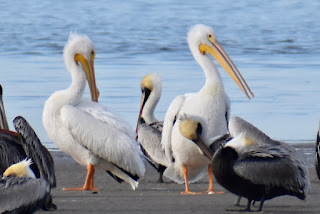A week after a 12-hour pelagic out of Cape May, my friend Jason and I took the seven-plus hour drive to North Carolina’s Outer Banks for a one day pelagic. The company there is a leader of east coast pelagics, attracting participants from around the world. Captain Brian normally operates his Stormy Petrel II vessel out of Hatteras during the spring and summer. This trip ran out of Oregon Inlet in Nags Head, shortening our commute by better than an hour each way. The drive took us through iconic Outer Banks towns like Kitty Hawk and Kill Devil Hills. Many think of Kitty Hawk as the place where Orville and Wilbur Wright made aviation history with the first flight, but that actually occurred in neighboring Kill Devil Hills. My first thoughts of the latter location are where the Weather Channel’s Jim Cantore brought live updates of approaching hurricanes.
The Wright Brothers National Memorial, N. Croatan Highway in Kill Devil Hills, NC. © S. Weiss
Our trip brought us to the Outer Banks for pelagic birds. Our main target was the rare sea bully, the Great Skua. We had no luck finding one off of Cape May the previous week and with scheduled winter pelagics running out, this was probably our last chance for the season. Unfortunately, our luck didn’t change. The only great skua the Stormy Petrel II came upon this season was, of course, last week. Despite that miss, we still had a good trip. The glut of alcids this winter continued south all the way down to Dare County, NC. The choppy conditions in the morning made it more difficult to spot birds sitting on the water. The first choice of alcids to elude an approaching boat is to dive, rather than take flight. They are good underwater swimmers, can stay below the surface for quite some time and often pop back up in a different location. Despite the early sea conditions, which settled down later in the day, we still tallied 423 razorbills, 34 Atlantic puffins, 4 dovekies one common murre and one thick-billed murre.


Razorbills. © S. Weiss
From a distance, razorbills can look very similar to murres. Razorbills have longer tails than murres though. When in flight, the tail protrudes past the legs, while a murres legs protrude past the tail. When sitting on the water, the razorbill’s tail often appears raised.
Dovekie © S. Weiss
Besides being about half the size of razorbills, dovekies fly with quicker wing beats and in a more erratic path.
Atlantic puffins. © S. Weiss
The Atlantic puffin is smaller than the razorbills and murres. It often has a grayer face this time of year.
Thick-billed murre. © S. Weiss
Thick-billed murres look very similar to common murres. One of the main field marks is the thick-billed murre’s bill is shorter and thicker. Also, in basic plumage, which we usually see this time of year, the thick-billed’s face is mostly dark whereas the common murre has white behind the eyes. Difficult to see in the right photo is a white gape line between the bill and eye, lacking in common murre. The common murre also is more brown than black in color.
Another bird we missed off of Cape May was northern fulmar, maybe because we didn’t make it as far out as we needed to be for New Jersey. We made up for that in North Carolina. The first fulmar was spotted only about ten miles from land. As we trekked farther away from land we began to get more fulmar sightings. At one point we came upon dozens of fulmars. They were sitting on the water and flying around the boat, near and far, in their graceful petrel and shearwater-like style. We saw both the predominant light morph and the less common dark morph varieties. For the trip we tallied 128 fulmars, 127 more than I had seen in my previous experience.
Light morph northern fulmars. © S. Weiss
Light morph fulmars are more common in the Atlantic. Dark morphs are completely charcoal gray in color.
Flock of northern fulmars. © S. Weiss
While out in the deeper depths, we came across some red phalaropes. Though technically slightly larger than a dovekie, they appear more dainty and harder to spot on the water. They tend to lift off and fly away when a boat approaches. They are considered shorebirds, in the same taxonomic family as sandpipers. Red phalaropes and red-necked phalaropes are the only two pelagic species in that family. In all, 83 red phalaropes were tallied for the day. The most I’ve ever seen at one time was during a December pelagic trip out of Cape May in 2020, when we came upon an incredibly huge flock sitting and chattering on the water estimated at 1,275 individuals.
Red phalarope. © S. Weiss
Unlike most birds, it is the female phalarope that sports the more colorful alternate (breeding) plumage. Red phalaropes and red-necked phalaropes look very similar in basic plumage. Red phalaropes winter in these waters while red-necked phalaropes winter off of South America.
Some other notable birds were a little gull and four Manx shearwaters. While out on the water we also came upon non avian sea life. Spotted and Bottlenose dolphins swam through our sights. Several whale blow spots lit up an area we were in, producing a close up view of a humpback whale. Pods of pilot whales added to the cetacean show. Probably the neatest non mammal sighting was a pair of ocean sunfish, one very large and one much smaller, that swam right next to the boat.
A pIlot whale’s bulbous head poking through the surface. © S. Weiss
Pod of pilot whales. © S. Weiss
There are two types of pilot whales: short-finned and long-finned. The difference between the two is not practical to spot from a vessel. According to Captain Brian, who has been doing these pelagics for many years, they were likely the short-finned variety.
Humpback whale. © S. Weiss
Ocean sunfish or common mola. © S. Weiss
Molas are the ocean’s heaviest bony fish and eat jellyfish. They are usually spotted at the surface and their dorsals fins look shark-like from a distance, but usually flop instead of holding up stiff.
American white pelicans roosting on an inshore sandbar. © S. Weiss
White pelicans are more common to the south and west than in the east. As seen here, they are much larger than the locally common brown pelicans. The bump, or knob, on the bill of the bird on the left indicates that it is transitioning to breeding status.
The proximity of the Outer Banks to the gulf stream and continental shelf makes pelagic trips on the Stormy Petrel II enjoyable and often unpredictable as to what one will see.























Comments
Post a Comment